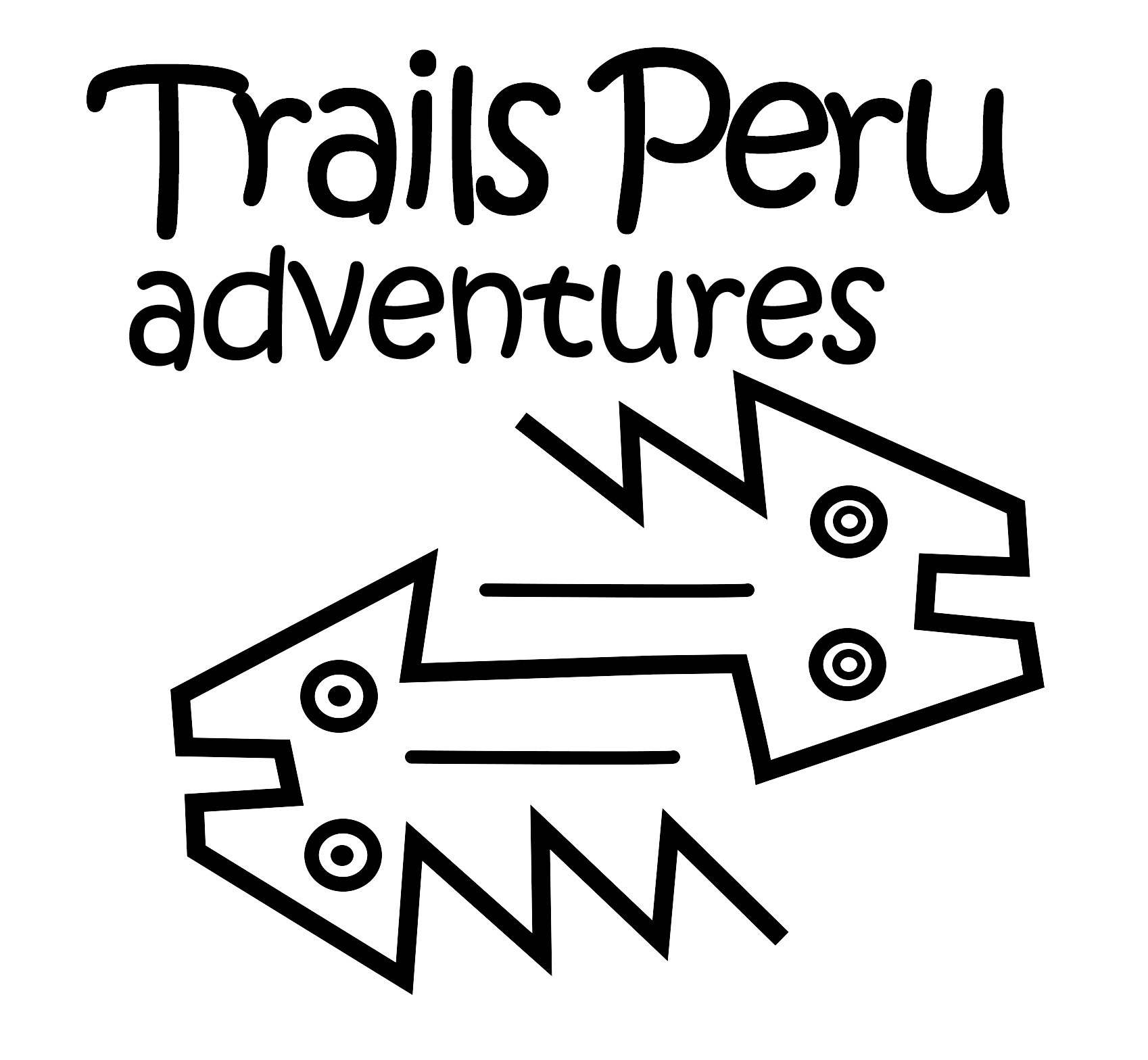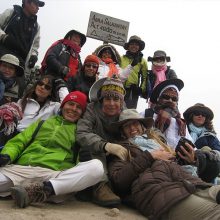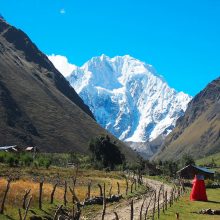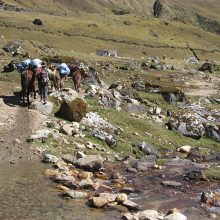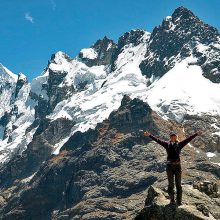
Salkantay Inca Trail to Machupicchu 6 Days / 5 Nights – antes
Mount Salkantay (6271 meters / 20,569 feet) is the highest peak in the Vilcabamba mountain range and one of the highest and most beautiful mountains in the Peruvian Andes. It is located about 60 kilometers (40 miles) northwest of the city of Cusco.
The 6 day Inca Trail offers a chance to enjoy stunning high altitude trekking in an area seldom visited by tourists, with the more traditional Inca Trail to Machu Picchu. Our route will take us from the base of Mount Salkantay, over the Incachiriaska (“Frozen Inca”) Pass, to finally join the world famous 4-day Inca Trail to Machu Picchu.
Inca Trail Availability
We offer daily Inca Trail departures (except February, when the trail is closed).
6 day Salkantay Trek and Inca Trail to Machu Picchu
Day One: Cusco – Soraypampa – Ichupata (12 kilometers, approximately)
We will collect you in the early morning from your hotel for the drive in our private transport to the village of Mollepata (2.5 hours), where we will stop for breakfast (cost not included) and explore this small village which is the traditional starting point for those embarking upon the Salkantay trek. You can also buy any last minute supplies you may need in Mollepata. From the village, we will drive for a further 1.5 hours to Soraypampa (3800 meters / 12,464 feet). From here there are magnificent views of Mount Humantay (5917 meters / 19,400 feet). We will stop for lunch here and take the time to enjoy this fine scenery. From Soraypampa to our campsite at Ichupata in the upper valley is a 2.5 hour hike. You will need to be prepared for the cold at this high altitude campsite. Given the altitudes experienced during the first section of this route, we recommend a period of at least three days in Cusco before departure, in order to fully acclimatize.
Day 2: Ichupata – Sisaypampa (12 kilometers, approximately)
Today we will continue our hike with a steep climb of between three and four hours up to Incachiriasca Pass (4965 meters / 16,285 feet). This is the highest point of our route, offering impressive views of the imposing peak of Mount Salkantay. After resting and enjoying the scenery, we will descend from the pass to Sisaypampa (4100 meters / 13,500 feet), an extensive plain where we will take a break for lunch while enjoying panoramic vistas of the surrounding valleys. It is also possible to spot condors along this section of our route. If we opt to camp at Sisaypampa, it will also be possible to make a short detour to Palqay Pass, which at 4500 meters (14,760 feet) offers a different view of Mount Salkantay, seldom seen by travelers.
Day 3: Sisaypampa – Ayapata (14 kilometers, approximately)
Today we will continue towards the village of Pampacahuana, in the vicinity of an Inca irrigation canal, arriving after around 3.5 hours. On this section of our route we will descend to approximately 3300 meters (10,825 feet). The Incas used complex irrigation systems to increase land area available for agriculture. From Pampachuana we will hike for between one and two hours down the narrow, steep valley as far as the Inca fortress of Inkaracay (also known as Paucarcancha). This little-known site is well worth exploring. From this archaeological site it is another thirty minutes or one hour to the small village of Wayllabamba, where we will join the famous Inca Trail to Machu Picchu. Because mules are not allowed on the Inca Trail (in order to avoid damage to the original stone covered Inca highway), here we will say goodbye to our mules and muleteers and welcome the porters who will accompany us for the next few days.
We will leave Wayllabamba behind in the afternoon to begin the hike up towards Warmiwañuska (“Dead Woman’s”) Pass. Before reaching the top of the pass, we will stop to camp for the night at Ayapata (also known as Yuncachimpa, approximately 3300 meters / 10,825 meters).
**Depending on our Inca Trail permits and the campsites that the Ministry of Culture allocates to us, we may need to hike to Llulluchupampa (3800 meters / 12,465 feet) which is another two hours along the Inca Trail from Ayapata. In such an event, we will probably camp for the night at Pampacahuana.
Day 4: Ayapata to Chaquicocha
Today we will continue our trek up to the highest point on the Inca Trail, reaching Warmiwañuska Pass (4200 meters / 13,776 feet) after around 2 hours. Descending from the pass, we will enter the Pacaymayo Valley (3600 meters /11,808 feet), from where we will climb to the next pass at Runkurakay (3970 meters / 13,022 feet). Half way to the pass, we will stop to visit the interesting Inca archaeological complex of Runkurakay. This site, located at 3800 meters / 12,464 feet, contains a small oval structure that is believed to have served as a watchtower. After crossing the pass, we will descend towards Yanacocha (“Black Lake”), entering the cloud forest on our way to Sayacmarca (3624 meters / 11,887 feet). This beautifully located archaeological site is composed of a semicircular structure. From here it is a further 20 minutes to Chaquicocha (“Dry Lake”, in Quechua), where we will make camp.
Day 5: Chaquicocha to Wiñaywayna
After breakfast we will begin the day with an easy climb up to the next pass at Phuyupatamarca (3700 meters / 12,136 feet). Phuyupatamarca is one of the most complete and best-preserved archaeological complexes on the Inca Trail to Machu Picchu, and is located on a mountain peak with fine views of forested mountains in every direction. In Quechua, Phyupatamarca means “city in the clouds”. From this magnificent spot we will descend via a series of stone steps built by the Incas to the archaeological site known as Wiñaywayna (2650 meters / 8692 feet). There is a lodge at this campsite, with a small restaurant, bar and hot showers. The campsite is named after the nearby archaeological site, just five minutes from the lodge (the Quechua name means “forever young”, an allusion the orchid which bears this name, and which grows locally). Wiñaywayna is an impressive complex, composed of an agricultural sector with numerous terraces, a religious sector and an urban sector.
Day 6: Wiñaywayna to Machu Picchu – Return to Cusco
We will start our day early (around 4:00 am) in order to arrive at the Sun Gate above Machu Picchu (2730 meters / 8792 feet) before sunrise. This early morning hike is the final part of the famous Inca Trail to Machu Picchu and from the Sun Gate you will have your first view of the city of Machu Picchu. After taking time to enjoy this spectacular sight, we will walk downhill along the final section of the trail to the spot where you can take the classic picture postcard photograph of this ancient city reproduced so often throughout the world. We will take a walking tour of the ruins lasting approximately 2.5 hours, in the company of our expert guide, after which you will have time to explore this Inca city independently. Those who have the energy can opt to climb Huayna Picchu hill above the ruins (2720 meters / 8923 feet). It takes around 45 minutes to reach the top (a permit to climb Huayna Picchu must be obtained in advance, when booking your Inca Trail). Finally, we will meet up again with the rest of the group and go down by bus or on foot to the small town of Aguas Calientes, where we will have time to eat before boarding the train to Cusco.
Those who do not opt to climb Huayna Picchu may choose to visit the following attractions in the outlying areas of Machu Picchu:
Inca Drawbridge
Machu Picchu Mountain
Temple of the Moon
We highly recommend walking down from Machu Picchu to the small town of Aguas Calientes, to get a feeling for the stunning location of the Inca city. It is a descent of around one and a half hours from the ruins to the town. Those who decide not to walk can take a shuttle bus from the ruins. We will return to Cusco from Aguas Calientes by train in the afternoon. The Expedition Class train leaves either at 2.30 pm or 6:00 pm and will take us as far as Ollantaytambo in the Sacred Valley, where we will be met by our private vehicle for the drive through the valley to Cusco. From Aguas Calientes to Cusco will be a journey of around four hours.
PLEASE NOTE: Government regulations mean that it is not possible for us to make your reservation for the Inca Trail to Machu Picchu without the full passport details of the client and full payment of the entrance fee to the Machu Picchu Historical Sanctuary. Limits on the capacity of the Inca Trail mean that only 500 people a day are permitted to hike the trail. Therefore, in order to guarantee your place on the Inca Trail to Machu Picchu, you must provide us with a scanned copy of your passport and a non-refundable deposit. Your reservation will only be confirmed when we have your entrance ticket in our hands. If your passport number changes before you start the tour, you must relay this information to us or risk losing your booking. You must take your original passport with you on the trail.
Itinerary notes – Salkantay and Inca Trail to Machu Picchu
- The times cited in this itinerary are approximate. Walking times depend on the group and the guide can change lunch spots and campsites, depending on the progress of the group. Each guide has their own preferred route and it might not correspond exactly to the route described here.
- Allocations or Itinerary are subject to change depending on time of booking and campsites provided by INC (institution that runs the Inca Trail).
- The above trek itinerary is our preferred option for this route. However campsites used during the Inca Trail section of the trek are subject to change depending on availability of spaces as issued by the Ministry of Culture, which are responsible for allocating the campsites to the authorised trekking companies. This is of particular importance for the last campsite, as WiñayWayna is the closest campsite to Machu Picchu, only being 2 hours trekking from the famous Inti Punku. (Sun Gate) However there is not enough space at Wiñay Wayna for all the Inca Trail groups. The next nearest campsite is Phuyupatamarca which is a 5 hour trek to Machu Picchu. When we buy the trek permits for the group we are allocated the campsites by the government.
If having WiñayWayna as your final night campsite is important to you – we strongly recommend that you book your Inca Trail tour as soon as you can. As a “rough guide”, of the 500 permits issued each day, the last 200 permits will be allocated to trekkers who will camp at Phuyupatamarca. As its actually to do with campsite allocation, not number of trekkers, we say “last 200 permits” as a guide, rather than a fixed rule. However, if you are booking last minute, you might expect that you will camp at Phuyupatamarca. The plus side is that it’s a relatively untouristed campsite! We recommend that you upgrade your train to Vistadome, or request to take the late Expedition train back to Cusco. (to maximise your time at Machu Picchu)
What’s included?
For complete facts about many aspects of Minka Peru Expedition tours, check out our FAQs page!
- Pre trek briefing
- Collection from your hotel in the morning of trek departure.
- Transport from Cusco to the trailhead
- Inca Trail Permit (includes entry to Machu Picchu, but not to Huayna Picchu)
- English/Quechua/Spanish speaking professional guide (you will have an assistant guide for groups over 6 people).
- Tents – 2 people in a 4 person tent which allows for greater comfort, and also storage of backpacks.
- Basic foam mattress. If you require greater comfort during the trek we can hire you an inflatable mattress (eg. Thermarest) .
- Cook and Cooking equipment (Assistants are provided for larger groups)
- Toilet tent is included for first 2 days of trek. Toilet tent is NOT included the Inca Trail part of the route, because we use facilities provided by the Ministry of Culture.
- Meals as indicated in the itinerary (optional vegetarian food). Our professional cooks prepare meals that incorporate elements of the western diet and also traditional Peruvian delicacies. (Please communicate with your guide/cook during the trek if you have a preference for certain types of dishes). Salads, if served, are washed in boiled water.
- Porters & Mules (for equipment and personal items) They carry camping equipment, food and kitchen utensils. We provide duffel bags at your briefing for your personal items (up to 7 kg per person). If you wish to take more, you can hire an extra mule or porter.
- 1 emergency horse which can be ridden if you are feeling ill or if are a little slower ONLY for first 2 days
- Dining tent with camp tables and chairs & Kitchen tent for the cook to prepare meals
- Tents for our staff to sleep in
- First aid kit including emergency oxygen bottle
- Bus down from Aguas Calientes – Machu Picchu
- Train ticket (Expedition service) from Aguas Calientes to Ollantaytambo
- Private transport from Ollantaytambo to Cusco.
- Lunch on the last day is included in this itinerary.
What is not included?
- Breakfast on the first morning.
- Dinner on the last night.
- Entrance to the thermal springs
- Entry to Huayna Picchu ($60)
- Tips: please note that our agency staff is well paid so please feel free to tip or not as you wish
You should bring:
- A light day pack with a change of clothes for the whole period of the trek – prepare for a vast range of changes in temperature
- Rain gear (jacket and pants if available) or rain poncho. Plastic ponchos can be bought for about $1 in Cusco .
- Strong footwear, waterproof trekking boots recommended.
- Warm clothes, including jacket, fleeces, gloves, scarf and beanie/touk. Thermal clothing is also recommended, especially for sleeping.
- Camera, films and batteries (batteries consume more quickly under cold conditions)
- Hat or cap to protect you from the sun, rain and cold
- Sun block
- After-sun cream or hydrating cream for face and body
- Insect repellent – minimum recommended 20% DEET – although no malaria risk has been reported
- Snacks: biscuits, energy bars, chocolate, raw fruits, muesli, etc.
- Non-disposable canteen (Nalgene type) and water for the first morning.
- We advise you to bring water sterilizing tablets in case you collect water from streams.
- Your own medical kit with any special medications that you might require, paracetamol, second skin for blisters etc.
- Small towel or sarong
- Bathers/swimsuit (if you intend on swimming in hot springs )
- Cash – sufficient for snacks, tips and souvenirs.
- Original passport & ISIC (International Student Identity Card) if you have one.
- Walking sticks or poles (we can hire these to you. Please note poles with metal tips cannot be carried into Machu Picchu and should be left at your hotel on the final day.
Prices 2019
[ninja_tables id=”2928″]
Optional Extras
- Deluxe Sleeping Bag suitable for -15deg. $5.00 per trip day.
- Walking stick lightweight aluminum $2.00 per day, per stick) Two sticks are recommended for tough hikes.
- Inflatable Mettress $5 per day.
- Aguas Calientes Extra Day & Upgrade.
HIRE POLICY:
- When calculating costs for hire of walking stick, sleeping bag, calculate using the length of the tour. Even though you won’t use the equipment on the final day it will still be ‘on the road’ and ‘occupied.’
- If you hire equipment and break it – you are responsible for price of replacement /or repair. (please do the right thing!)
AVAILABLE DISCOUNTS (these discounts are not cumulative)
- Students: US$ 30.00 (students require a valid International Student Identity Card. Please beware that Youth Travel Cards are not valid)
- Teenagers: US$ 20.00 (up to 15 years of age, passport copy required for all bookings)
- Children: US$ 45.00 (up to 10 years of age, passport copy required for all bookings)
- Check Availability Here
